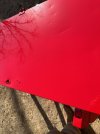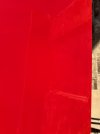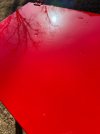I have not got around to it yet, but I am going to spray a couple of junky metal cabinet doors I have to see what is what. I'm sure reducing it is the solution at least for the gallon I have, and the tools I am using. I need to get it figured out as I am getting close to being ready to spray the hood.
You mentioned of spraying and then coming back and seeing way more orange peel than when it went on. This was a problem I fought for quite a while doing work outside of a large, dedicated paint room of ample volume. I got around this and most of the time it is glass on my good stuff by getting it where I think it needs to be on my sample test piece first. Sometimes it was more than a couple of tries. But I know now what variables are apt to lead me where I want to be without it being a mystery. But I know now how to compensate for my choice of guns, how much overlap--speed of my movement, etc...... My work before resembled yours. I needed to up my airflow through my spray guns.
Hang in there and try what people advise and see what works for you.
People always talk about how something sprays--the other part is how that sprayed material behaves on what it lands on.
I use a 4'x5' piece of 20 sheet steel gauge hanging on the wall that is my set-up piece--since I only use my equipment on occasion. I use an inexpensive plastic Earlex brand Ford #4 viscosity cup ($4.95USD) and time with a watch and keep my SATA one for a reference. I just swish this plastic cup in my nasty can of used thinners/reducer/xylene/laquear thinner to clean it and not rub it dry. All the single stage I use is timed /reduced to run 14-18 seconds in that Ford cup or 19-22 seconds in a Zahn #2 cup at 70-75F. Some paint manufacturers list a Zahn# 2 cup with a timing in seconds. The Zahn cup uses a smaller hole and is harder for me to see it at the final drain out. I use both but prefer the Ford #4. They are accurate to my SATA one to 1/3 second timing with a Swiss made stop-watch and however accurately I can tell when the last of the exits the end of the opening in the viscosity cup.
Once I have that timed inside in the house or controlled temp place--I change-out my fluid nozzle, air cap and needle to compensate for higher or lower temps or humidity are where spraying will be. I change out the guts of the gun to match and leave the paint alone. If it is a bit cooler--I heat on a hot plate and get it 75F. I match my activator to environmental conditions per what that manufacturer recommends and usually go one higher temp. range on my reducer. Then I consider if I will go up or down on my fluid nozzle orifice and the same on the air cap. Colder days--smaller fluid nozzle and bigger air cap. Some needles that are for the next sized down fluid nozzle will work fine and allow for a touch more fluid output for a fine tune. I can just run the adjuster in or out on the end of the needle to make sure it does not overly protrude from the fluid nozzle and still seals. I do this on my touch-up guns.
My experience is CFM x PSI should be somewhere about 300 as an idealized number--on a full-sized production RP, HVLP, conventional spray gun and most can be made to perform well but it is not likely with one gun set-up of fluid tip, needle, nozzle unless you can adjust your environment by temp/humidity and airflow. That multiplication product is in units of power (time rate of doing work). The CFM number the manufacturer states is the minimum flow through--not the amount you might need for what product you intend to spray and where you are spraying. Using a vane type anemometer and 8" long piece of cardboard shipping tube measuring gets you a better estimate on CFM out your gun and from however many restrictions you've put in your piping/hose--then you can fine tune pressure at the wall with the gun trigger pulled completely open. If you need a bit more volume--go to a 1/2" hose and measure the flow difference from a 5/16" or 3/8" one.
For folks who have this urethane wave problem mentioned on this forum--might want to check the air velocity exiting your gun with an anemometer for feet/sec. and a just lower by increasing your CFM flow a tad and decreasing your spraying pressure. Higher spraying pressures often are associated with higher air velocities out the gun impacting the substrate being sprayed.



